本文由Sasaki授权mooool发表,欢迎转发,禁止以mooool编辑版本转载。
Thanks Sasaki for authorizing the publication of the project on mooool, Text description provided by Sasaki.
Sasaki:上海蜕变为一个具有全球影响力的国际大都市是非同凡响的,而其作为区域商贸枢纽的形象,更代表了现代中国的一个表征。随着城市化发展规模的扩大,不少主要城市为了经济发展而牺牲了环境或历史资产。更令人遗憾的是,这些祖辈留下的宝贵文化遗产如今有些只能从照片影像中找寻。如何守护我们博大精深的华夏文明和精神家园,让它们可以在新时代继续绽放光彩?
Sasaki: Shanghai’s evolution into a globally-influential metropolis is extraordinary, and its identity as a hub of commerce is a symbol of contemporary China. Like many major cities experiencing significant growth, some of Shanghai’s progress has been at the expense of its historic assets, many of which remain only in photographs and memory.
▼蟠龙天地为上海历史水乡新添活力与生机,既致敬文化传承,又彰显以景观为主的新水乡内涵 Panlong Tiandi adds new vibrancy to one of Shanghai’s historic water towns, respecting its legacy while establishing a new identity centered in the landscape.

在中国各地拥有近二十年对文化历史建筑改造利用成商业物业开发经验的瑞安房地产,联袂Sasaki、Ben Woods上海工作室和天华建筑设计公司,共同打造蟠龙天地总体规划项目,致力于将其转变为别具特色的文化社交目的地,并通过全新方式构建公共空间以及支持多元社区的便利设施,再现该地区的文化经典。
Shifting this narrative and building upon nearly two decades of expertise with the adaptive reuse of culturally sensitive sites throughout China, developer Shui On Land engaged Sasaki alongside collaborators Ben Woods Studio Shanghai and Tianhua Architecture & Engineering to lead the design of Panlong Tiandi, transforming it into a vibrant mixed-use district guided by a celebration of its heritage, an inventive approach to public space, and a host of amenities that support a diverse community.
▼这片区域以公共交通运输为导向,位于国家会展中心以西一站处,与周边环境相辅相成,形成了商业和文化枢纽 Located one metro stop west of China’s National Exhibition and Convention Center, the transit-oriented district compliments and serves as a commercial and cultural hub for nearby destinations.
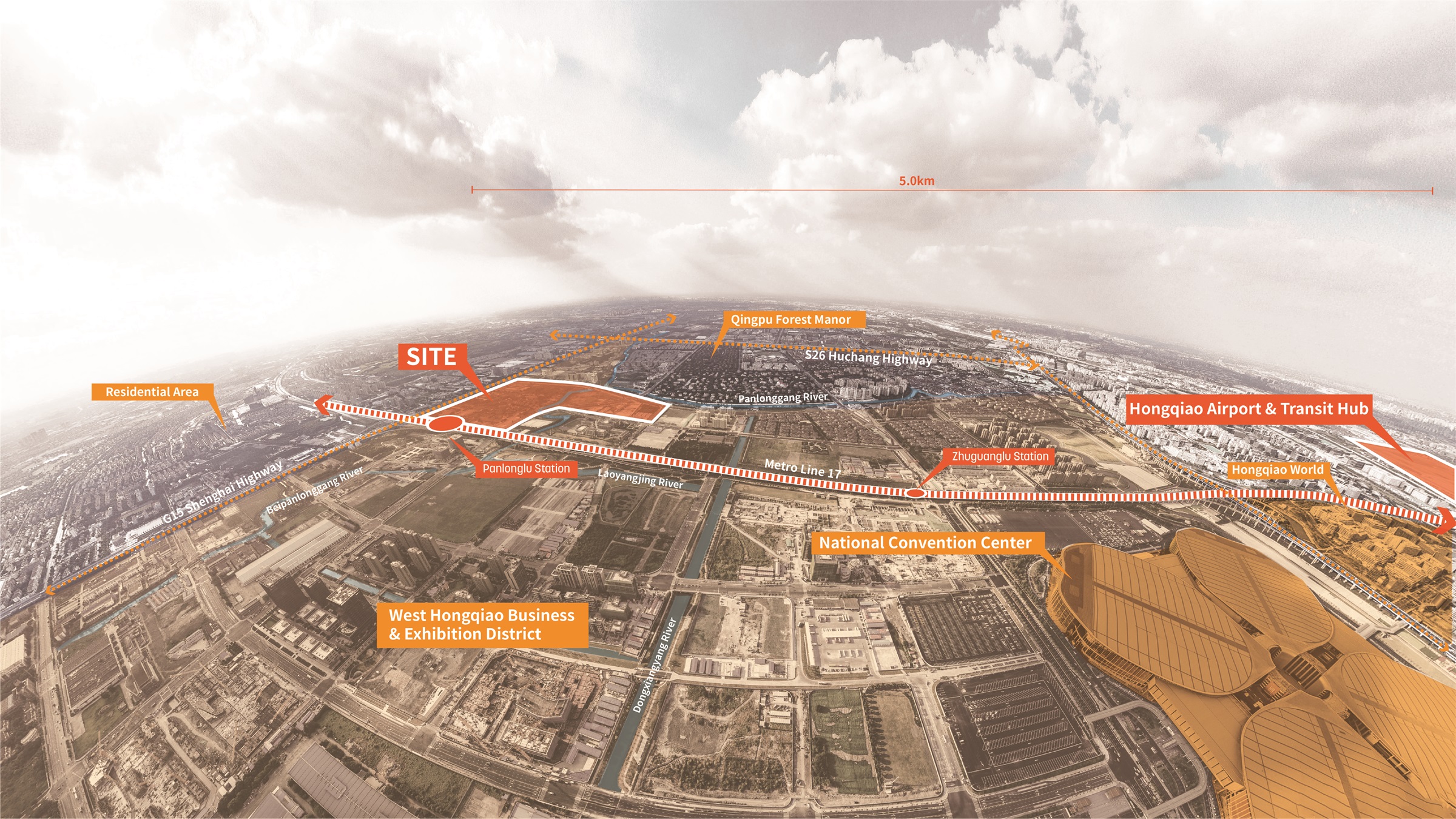
江南水乡古镇大多遍布于江浙地区与上海地区内,有着1400余年历史的蟠龙镇正是其中之一。蟠龙古镇的肌理反映了典型的古镇形态,历史建筑沿着河岸而建,碧波荡漾、一座座古桥因水而生,亦是河岸两侧的纽带。设计团队围绕唤醒古镇脉络的规划原则,极力维护古镇街巷空间结构。那些承载些许岁月痕迹的建筑,狭窄的街道和其他原始空间形态,通过设计人员的精心协调,实现了新旧城区间的规划统一。
Panlong is one of China’s ancient water towns, many of which are located in the greater Shanghai metro area and throughout Zhejiang Province. Originally built over 700 years ago, Panlong’s urban form is typical of the region’s ancient vernacular, with historic buildings straddling both sides of a canal and bridges providing critical pedestrian links across. Beginning with a strategy for the adaptive reuse of the historic village core, the design team outlined a conservation plan that maintained the ancient urban fabric. Existing alleyways, narrow streets, and other key features of the public realm were also retained, and new streets were carefully aligned to respect the integrity of the old town.
▼蟠龙天地旨在成为上海市区内的新胜地,其规划设计既凸显景观特色,又传承悠久文化历史 Positioned as a new urban destination to serve all of Shanghai, Panlong Tiandi was programmed and organized to prioritize the landscape alongside its rich cultural history.
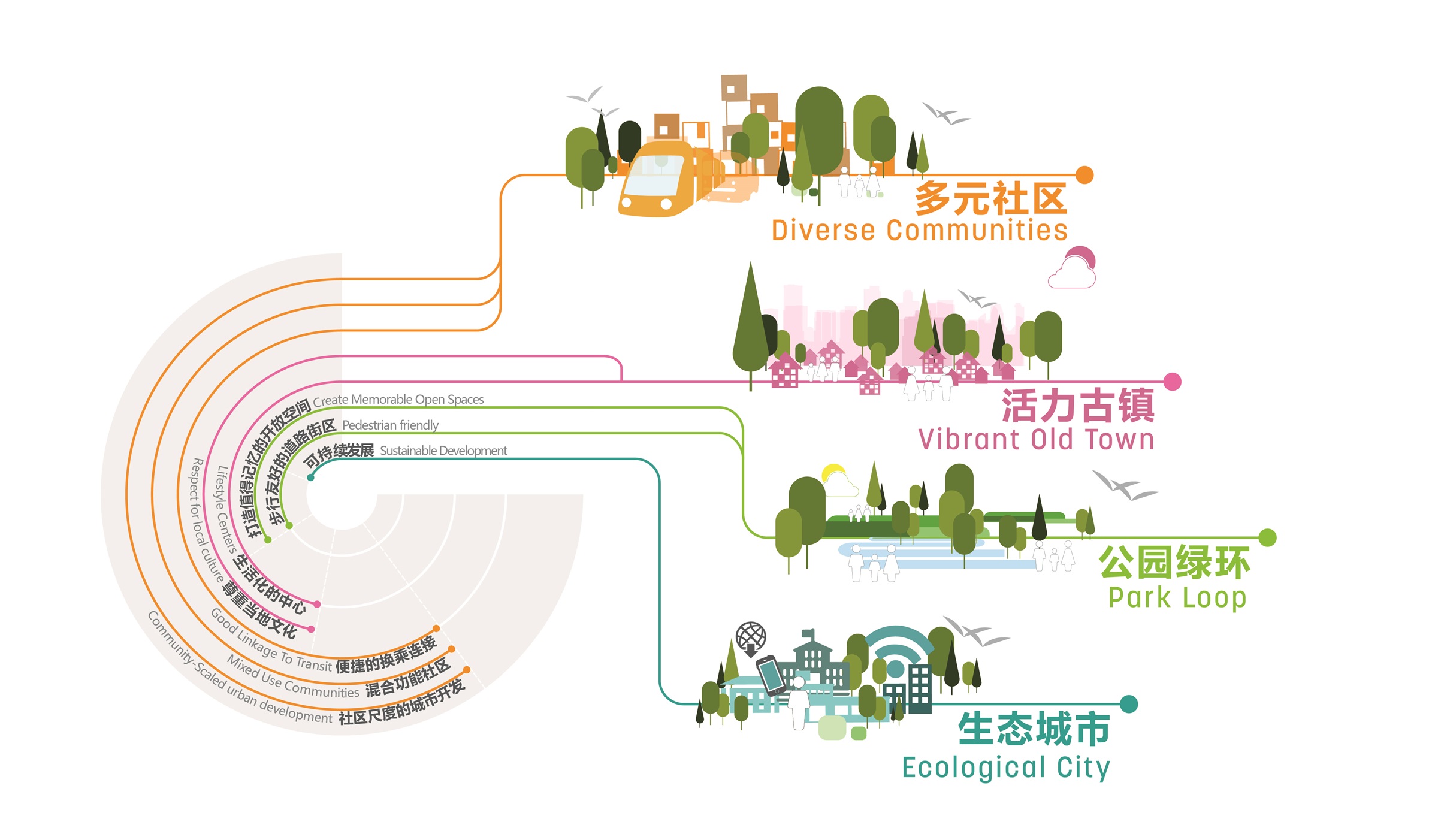
▼总体规划将古镇中心的步道延至周边城区,这个策略也吸引游客从几个主要入口进入公园,一路漫步到古镇中心 The master plan was structured to extend the pedestrian street of the historic core into the surrounding urban context. This strategy draws visitors through the park into the center from key access points.
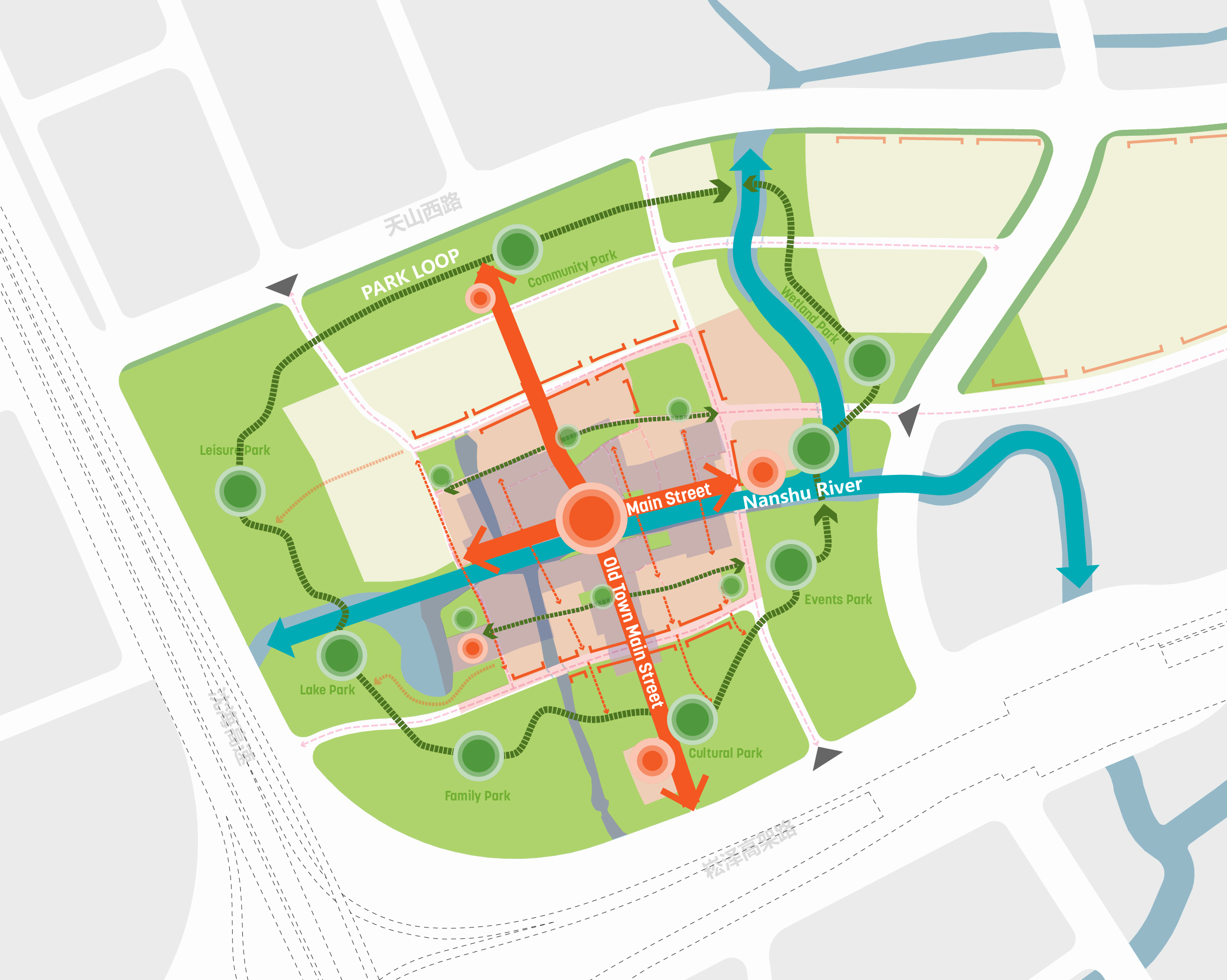
这种策略方案在历史文化遗产改造和房地产开发之间建立了共生合作的方式。核心板块形成集文化、娱乐和生活方式为一体的“江南新天地”,临近的社区也为区域与古镇提供活力与生机。值得一提的是,从古镇中心向外延伸,透过城市设计的细心布局,既保留了古镇历史文化印记,减少视觉上的冲击,也达到新旧区域彼此间的融合共生。多样化的居住形态,构建出繁华大都会深处的生活居所,将不一样的江南意境呈现在大众视野中。
This approach established extraordinary synergies between historic preservation and real estate development, creating a mix of cultural, lifestyle, and entertainment destinations at the core, with a residential neighborhood that provides additional vibrancy beyond. Detailed massing studies of the residential district led to a careful arrangement that reduced visual impacts. Cascading setbacks from the center of the village ensured that new buildings would not cast shadows or obstruct views from within the historic core. The result is an eclectic neighborhood that is not treated like a museum, but rather perpetuates its history through new and creative uses.
▼创新的公共空间和量身定做的配套设施,服务充满活力的社群并提供多元化体验 An inventive approach to public space and bespoke amenities support a vibrant community with diverse experiences.

▼经过一连串的体量研究,周边增加的建筑物不会造成古镇内的视线冲击 A series of careful massing studies ensured that new buildings were sited such that they would not obstruct views from within the historic core.

蟠龙天地在这过去曾经是上海城市近郊的地段, 扮演了主要的城市目的地。随着虹桥商务区的发展,对望国家会展中心,紧邻地铁17号线蟠龙路站,2站即达虹桥综合交通枢纽和国际机场。
便利的交通、低密且宜人的城市形态、有效减少与交通有关的碳排放等策略方针,使蟠龙天地为可持续城市发展树立了新典范。该开发项目的其他功能还包括建筑材料的循环再利用,从而减少了项目的整体隐含碳排放,并通过景观手段过滤装置和补给地下水系统来减少雨水径流。
Although once considered at the fringe of Shanghai, Panlong Tiandi is an urban destination amidst its suburban context. Strategically situated along metro line 17, Panlong is one stop west of the new National Exhibition and Convention Centre, and two stops from the Hongqiao railway station and Hongqiao International Airport.
Convenient access to transit and a dense and walkable urban form contribute to reduced transportation-related carbon emissions, and are one of many strategies leading to Panlong Tiandi’s objective of setting a new paradigm for sustainable urban development. Other features of the development include reuse of building materials leading to a reduction in the project’s overall embodied carbon, and limiting stormwater runoff with a landscape that prioritizes filtration and groundwater recharge.
▼河畔的空间回应了亲水设施与功能,除了加强连通性,还打通整条滨水步道 Edge conditions along the canal responds to adjacent program, improves accessibility, and creates a contiguous pedestrian waterfront.

▼总体设计方案将过去定义上的城市缓冲带空间改造为可容纳各类活动项目的户外休闲场所,与蟠龙的悠久历史交织在一起 The plan transforms the traditionally underutilized edges into a public park brimming with programming and activity that is interwoven with the rich history of Panlong.

▼整个项目也被称为“公园中的新天地”,以丰富的景观奠定了蟠龙天地的新江南人文内涵 Colloquially referred to as“Xintiandi in the Park”Panlong Tiandi reflects the importance of the landscape to Panlong’s renewed identity.

蟠龙天地最显著的特质之一是环绕历史核心、内外互补的大片景观资源。Sasaki团队把规划中常见的防护绿地视作“契机”,挑战无所不在的防护绿地的使用机能,并作为整个项目的主要特征之一。这项大胆的方案将传统意义上那些未被充分利用的空间重新定位为户外休闲场所,并与蟠龙悠久的水乡文化交织在一起。
One of the most significant features of Panlong Tiandi is the generous public landscape surrounding the historic core. Viewing the large setback requirement as an opportunity, Sasaki’s design challenged the typical approach to Shanghai’s ubiquitous buffer landscape condition by rethinking it as a central feature of the development. This bold move repositioned what is traditionally underutilized space into a public park brimming with programming and activity that is interwoven with the rich history of Panlong.
▼四季花园的设计灵感来自于《蟠龙镇志》文史资料中对于场地的描述 The Seasonal Flower Park is one of the reimagined scenes inspired by historical accounts from the Panlong Chronicle.
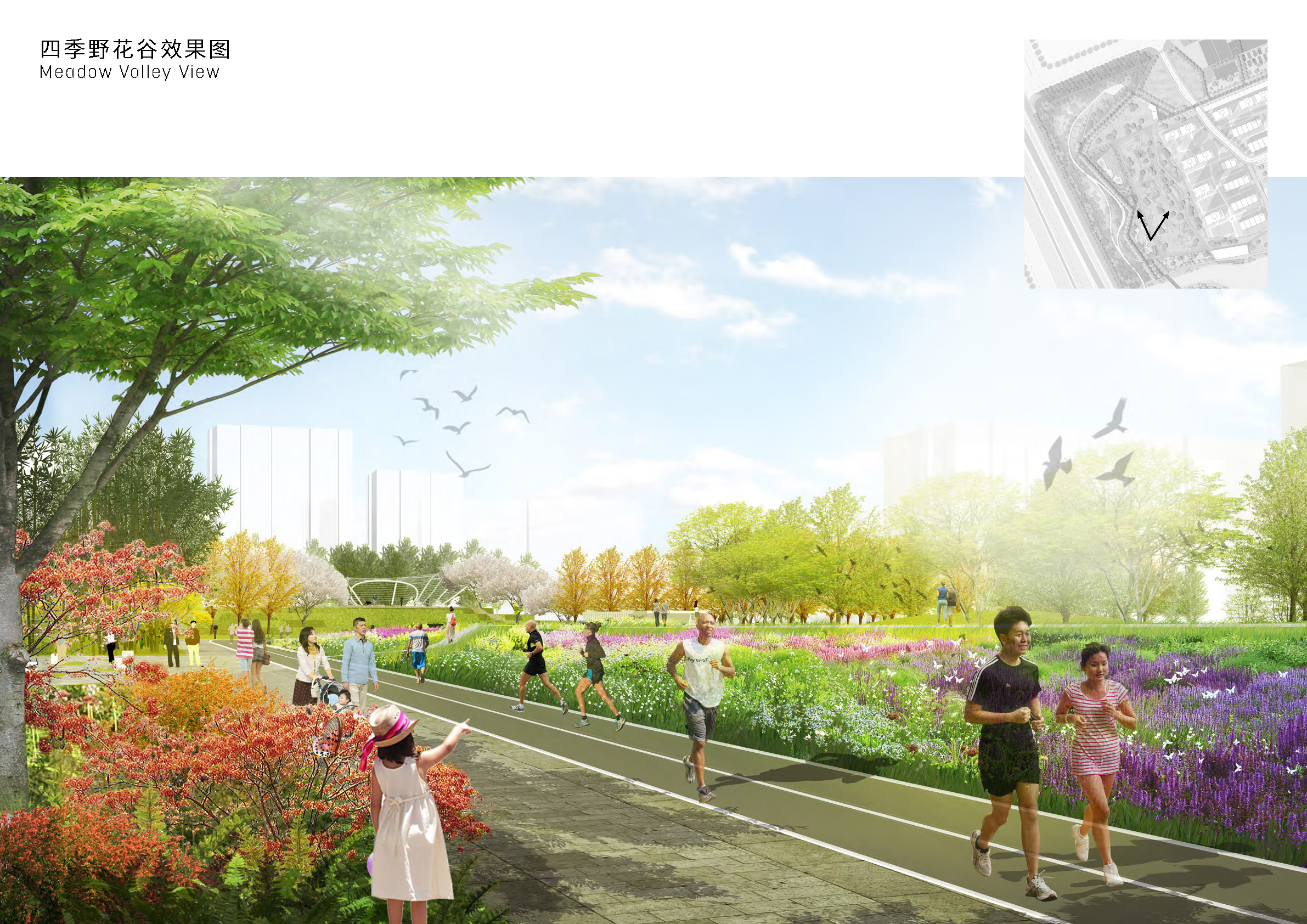
▼人们可尽情开展亲子活动,探索大自然的奥妙, 享受区域里大量的开放空间资源 Family activities and nature-based exploration take advantage of the district’s abundant open space.
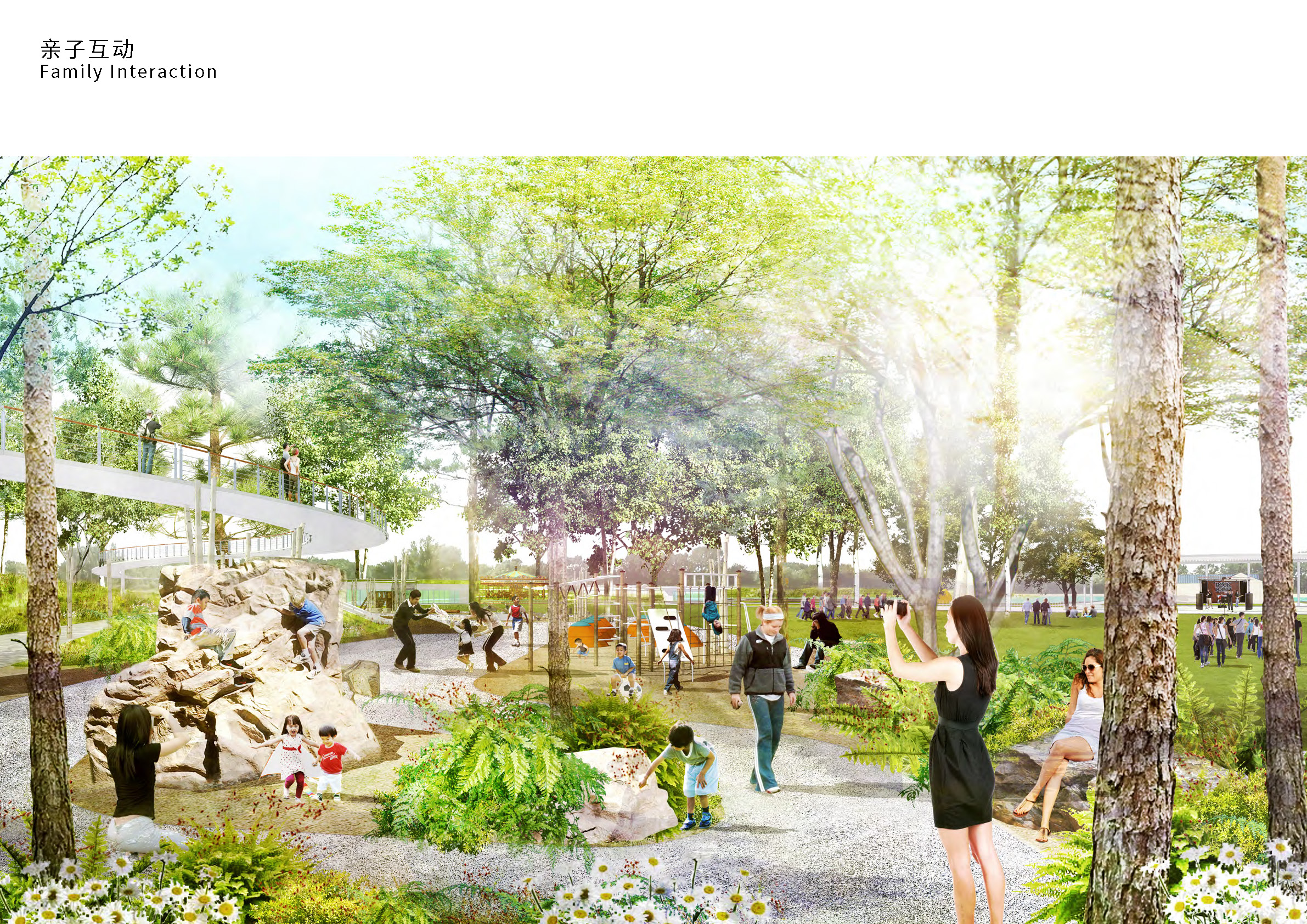
整个项目也被称为“公园中的新天地”,以丰富的景观奠定了蟠龙天地的新江南人文内涵。设计团队围绕Culture(文化唤醒)、Nature(自然融合)、Future(城市焕新)三大核心信念为公园的设计提供了灵感。首先,是对《蟠龙镇志》中记载的“蟠龙十景”进行全新诠释, 从布局规划到植被设计。其次打造的是约2.5公里的环形主步道“蟠龙道”,这是由古镇修复过程中剩余的屋顶瓦片建造而成,它将八个特色各异的主题公园相互串联。
As a result, the new development is colloquially referred to as “Xintiandi in the Park” reflecting the importance of the landscape to Panlong’s renewed identity. Three main elements provided the inspiration for the park’s design. The first is a contemporary reinterpretation of the 10 Scenes of Panlong as documented in the Panlong Chronicles, which informed spatial organization and planting selection. The second was the creation of “Panlong Dao”, which is a journey through the park’s various landscape typologies via a path constructed from reused roofing tiles left over from the renovation of the village.
▼空中林间步道不仅使行人能以独特的视角俯瞰古镇,还可借此机会尽情沉浸于大自然 An elevated canopy walk provides a unique perspective of the old town from the treetops, while also providing an opportunity to become immersed in nature.

最后,设计团队带你步入空中林间步道这个不容错过的景观设计元素,利用公园的微地形俯瞰古镇和公园全景,并可以近距离细致观察各种植被。从公园循序渐进到古镇的核心肌理,利用周围景观的尺度转化,潜移默化引导行人体验。沿路途径的小型口袋公园与环绕古镇的蟠龙公园形成鲜明对比,提供了更灵活的活动和社交空间,不只为民众在紧凑的肌理中带来舒适体验也提供方向指引性。
Finally, the canopy walk is a unique element which takes advantage of the park’s micro terrain to provide an elevated perspective of the village and the park below as well as up close observation of the diverse planting from a rare vantage point. Connecting the park to the historic core, entry points from the surrounding landscape are strategically aligned to guide pedestrians towards smaller public spaces within the village. These smaller pocket parks provide a contrast to the grand landscape enveloping the old town and offer flexible event and social spaces, act as helpful orientation points, and provide breathing room within the compact urban fabric.
▼蟠龙天地在历史遗产保护、活化再利用和房地产开发之间建立了共生合作的方式,创造出上海独一无二集文化、生活方式和娱乐为一体的胜地 Panlong Tiandi establishes extraordinary synergies between historic preservation, adaptive reuse, and real estate development, creating a cultural, lifestyle, and entertainment destination unlike any other in Shanghai.
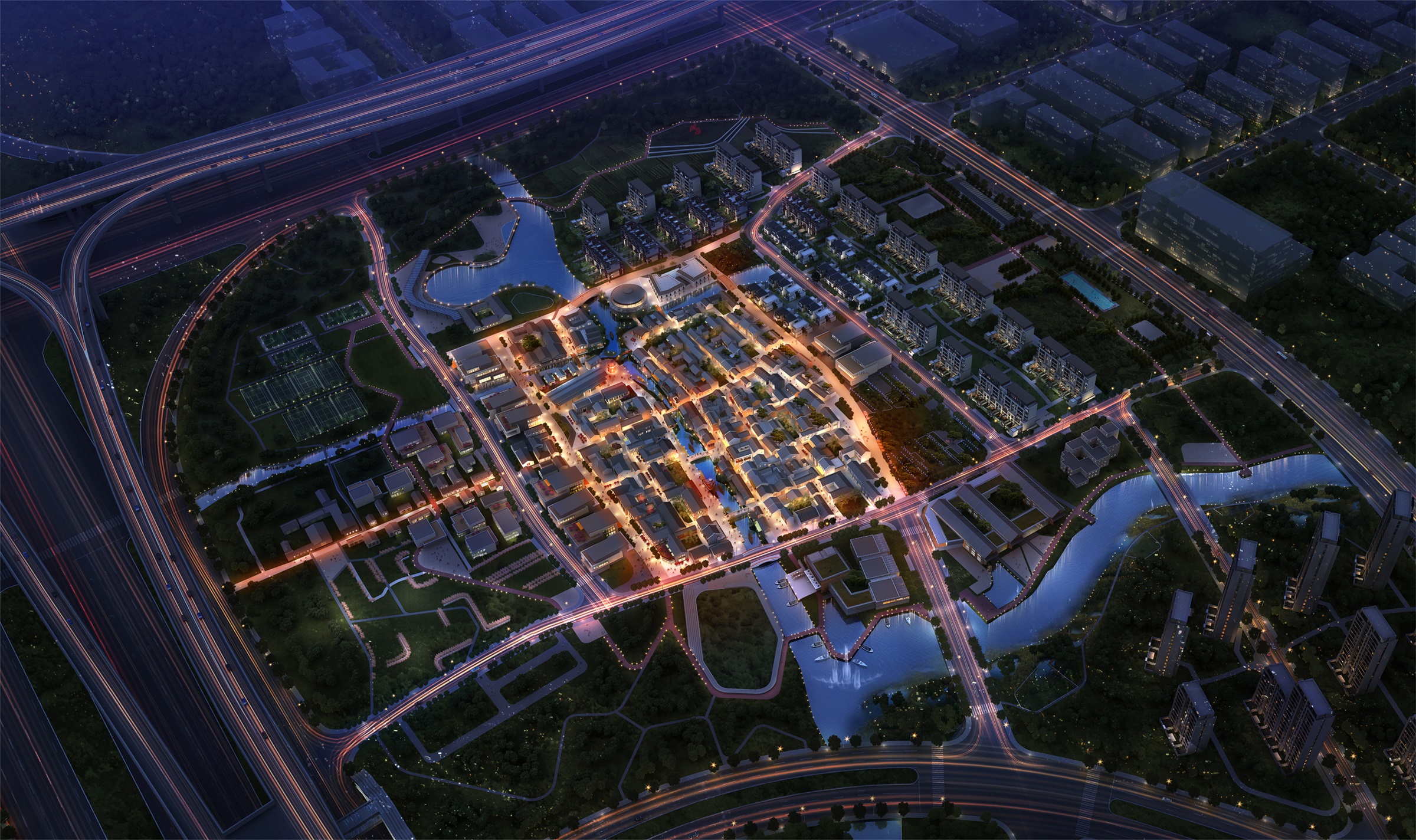
上海作为一个前瞻的国际大都市,对新思想秉承开放态度,并以志在必得的信心和决心打造城市愿景。然而,我们也可以向过去学习,检视挖掘历史上成功的要素。蟠龙天地正是一个根植过去彰显无形资产的启示,使得这片土地在沉寂百年之后重回舞台,提供未来世代享乐文化传承的新价值。
Shanghai has always been a forward-looking city, open to new ideas and willing to reinvent itself to achieve greatness. But sometimes successful ideas can come from a careful examination of the past with an eye towards repurposing what already remains as a catalyst for the future. Panlong Tiandi is an appreciation of what our ancestors left us, and a celebration of their contribution by repurposing their legacy for the enjoyment of future generations.
业主:瑞安房地产
规模:55 公顷(蟠龙公园 22公顷)
合作团队:古镇商业建筑师:Studio Shanghai ;住宅建筑师:天华建筑设计公司;当地景观建筑师:华东建筑设计研究院
专业领域:景观/规划与城市设计
现况:总体规划 2015 年完成 (蟠龙公园建设中)
Client: Shui On Land
Size: 55 Hectares (Panlong Park 22 Hectares)
Team: Ben Woods Studio Shanghai ; Tianhua Architecture & Engineering ; ECADI
Services: Landscpae Architecture/Planning and Urban Design
Status: Master Plan (Completed 2015) ; Panlong Park (Under construction)
更多 Read more about:Sasaki




0 Comments